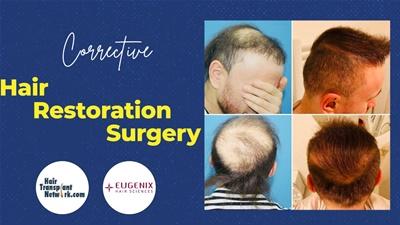It is always sad to encounter countless scarred souls who come to correct their botched-up, horrendous hair transplants from across the world. Most of these patients come to Eugenix after making the impulsive decision to go for a transplant without doing the necessary research whatsoever & getting the procedure done next door, which is often a cheap and ‘‘famous’’ destination for many.
Hair Transplants Gone Wrong
Very soon after the surgery, they realize that things have gone wrong. Most of these patients end up with a very strong, abrupt, coarse & linear hairline, and their peers often make rude comments to them for having a hair transplant done. Usually, these enthusiastic youngsters go for extreme lowering of their hairline, flatten the frontotemporal angles or try to look like a teenager with some job done at the temples.
Since the frontotemporal angle is flattened up in most of these cases, the hairline is feminine. If the temples are done, they look like horns having halo baldness around them. With the thick, coarse multiple hair grafts on the frontal aspect of the face, the overall look becomes very un-aesthetic and catastrophic to the patient.
The temples should instead be considered as part of the face & not the scalp. If they are un-aesthetically done, every time the person looks at himself in the mirror, he becomes saddened and depressed. Usually, these patients also have a poorly managed donor area patchy, uneven with excessive extraction of grafts. Therefore, these patients cannot keep their hair short, which defeats the purpose of Follicular unit extraction (FUE).
Donor Area Damage
Doctors/clinics who do not have the skill and judgment to do justice to the recipient area do equal damage to the donor area. When we encounter such patients, the first emotion that evokes in us is sadness, and after that, we use all our skills to do a corrective procedure that is long-lasting & futuristic. Usually, it involves extracting the bad hair from the FTA & temples, correcting the lowered hairline, giving it the proper positioning & addressing any tenting/pitting or follicular prominence.
We also fill any halo of baldness around the transplanted area in temples and the frontal part & make the new hairline softer. Most of the time, it is impossible to extract all the bad hair in one go. Sometimes, two to three passes are needed, including laser hair reduction. While doing all these exercises, it is essential to not leave behind any ugly, bad-looking scars on the face. Extremely experienced & skilled hands are required to do justice to a corrective hair transplant.
Clinics/Doctors/Places who take up these youngsters for their hair transplantations without proper education primarily do the procedure for commercial gains. They are never in a position to give a long-term, futuristic approach to these immature kids. Just because somebody is desperate to get his hair transplant done doesn’t mean they need a procedure or should get one. Two things are essential here – education of the doctor/clinic & education of the patients.
Avoid Corrective Surgery Through Research
The doctors/clinics should have enough scientific knowledge of holistic management of hair restoration (surgical & non-surgical). They should also have enough skills to understand drugs, their effects, and potential side effects and should have enough skills to address hair loss issues. This is only possible if the doctor/clinic focuses only on hair restoration and is passionate about it. In addition to the skill & passion, the following but more critical virtues that a doctor should necessarily have are ethics & empathy. To us, a doctor should have the soul of a parent who guides a youngster in making a decision & they do not see the patient as a client who is ready to empty his wallet.
By doing such procedures, an uneducated clinic/doctor commits a blunder. Most of the time, saying ‘’NO’’ to a non-eligible patient is a much more significant achievement than making him falsely happy for a short time. But an educated clinic/doctor who decides to do the same surgery commits a crime, which is only for commercial gains, without considering the psychological complications that the patient will have later on in his life.
The second part of the education is for the patients. We would advise all the patients, young and mature, to spend a lot of time on self-education. We believe at least one year should be spent on research by every patient. Patients are encouraged to go to various forums to read stories of past patients and interact with them. They should ask different clinics to share the details of the patients with whom they can potentially talk & meet in person. They should remain away from clinics that are not patient-focused and only interested in booking them for the procedure. The hair follicles are finite, non-renewable, the surgeries irreversible, and the scars are permanent. Spending one year to research a cosmetic procedure is the minimum that one should do.
Hair Restoration Network is the biggest, oldest & most reputed patient hair loss forum in the world. It is an ocean of knowledge for patients. They should bathe in this forum daily to have the right weapon to take the final decision once forever. The pearls of wisdom present at the depths of the ocean of Hair Transplant Network would be the greatest gift to all the thirsty, researching souls of hair transplantation who are scared that they might get a bad hair transplant. Slowly but surely, over a year or so, most of the patients become educated enough about hair transplant and its forthcoming potential outcome that they choose the best option for them while also keeping their expectations practical.
To summarize, education is the key for both clinics/doctors and the patients to avoid the eventuality of a corrective hair transplant. We promote science to be practiced most ethically while considering each patient as our family member.
Written by Dr. Pradeep Sethi of Eugenix Hair Sciences
Edited by Melvin Lopez

